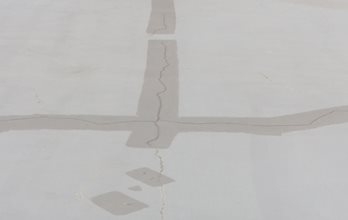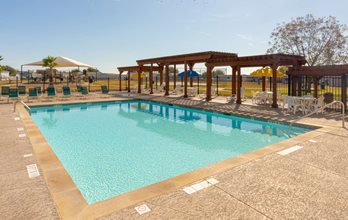Get Concrete Crack Repair in the Austin Area
Learn how to fix cracks in concrete patios, driveways, pool decks, and more.
Concrete is known for its strength and longevity, but even well-installed slabs can crack. Rather than tearing out the entire surface and starting from scratch, repairing and/or resurfacing concrete is often a more practical and cost-effective solution.
Get a free quoteWHY DOES CONCRETE CRACK?
Cracking can happen for several reasons. Improper installation, such as an incorrect water mix or failure to install control joints, can lead to cracks. Even when installed properly, concrete’s natural limitations can cause issues—while it has excellent compressive strength (resisting heavy loads), its tensile strength (ability to flex or stretch) is lower, which makes it prone to cracking.
TYPES OF CONCRETE CRACKS
Different cracks require different treatments, depending on their cause and severity. Here’s a look at common types of cracks and how to address them:
Hairline Cracks
These fine cracks typically result from the natural shrinkage that occurs as concrete cures. They don’t indicate structural problems, but they still need to be repaired. Leaving them alone may allow moisture to penetrate and the crack can worsen over time.
Solution: Hairline cracks are typically filled with a crack filler or adhesive to prevent further moisture damage.
Shrinkage Cracks
Often wider than hairline cracks, these are caused by the concrete drying too quickly or by using too much water in the mix. They usually appear in a random pattern.
Solution: Filling shrinkage cracks can often prevent them from spreading. In more severe cases, resurfacing the area might be necessary.
Settlement Cracks
These occur when the ground beneath the concrete wasn’t properly compacted, or when heavy loads were applied before the concrete fully cured. These cracks are often wider and may be accompanied by sinking in the slab.
Solution: If settlement cracks are minor, grinding and sealing might solve the issue. For more extensive settlement, resurfacing or even replacement may be needed.
Structural Cracks
The most serious type of crack, these occur when the concrete’s integrity is compromised, often due to poor reinforcement or foundation shifts. They tend to be wider and deeper than other cracks.
Solution: Structural cracks may require significant repair or reinforcement. In some cases, it may be more cost-effective to replace the slab entirely.
UNDERSTANDING THE CAUSE OF CONCRETE CRACKS
By determining the cause of cracking, you can try to prevent future issues. Whether the cracks are caused by environmental factors (such as moisture or freeze/thaw cycles) or improper installation, different repair methods are required. For instance, cracks caused by corrosion in the steel rebar may require more than just a surface repair. A professional contractor can assess the problem and recommend the best course of action.
OPTIONS FOR REPAIRING CRACKED CONCRETE
Here are some of the techniques our contractors use to repair cracked concrete:
- Custom Scoreline Effect: A technique pioneered by SUNDEK, this method incorporates existing cracks into the design of the concrete surface. These cracks act as natural expansion joints, and we enhance their appearance to blend with the design of the slab. See a project SUNDEK of Austin completed using the Custom Scoreline Effect.
- Repair the crack: With this option, we repair cracks individually. If you opt for this, you may want to resurface the concrete to give the entire slab a consistent look.
- Remove and replace: If the cracks are too severe, repairing them may not be a good long-term solution. If you think you may need to replace your surface, it’s best to have a professional such as SUNDEK come look at your surface and advise you on the best options.
 At Saddlebrook in San Marcos, TX, SUNDEK of Austin resurfaced a community pool deck, applying Classic Texture in Mission Tan.
At Saddlebrook in San Marcos, TX, SUNDEK of Austin resurfaced a community pool deck, applying Classic Texture in Mission Tan.RESURFACING: AN ECO-FRIENDLY ALTERNATIVE
If the concrete is still structurally sound, resurfacing is a simpler option, and it’s also more environmentally friendly. With resurfacing, rather than tearing out the old slab, a contractor prepares the surface then adds a new layer of material on top of the existing concrete. This method saves both resources and labor while also reducing waste.
COST OF CONCRETE CRACK REPAIR
The cost of repairing cracks varies depending on the type and extent of damage, and how you plan to address it. Small hairline cracks that you can repair yourself may only cost you the price of crack filler and tools. For more extensive or deep cracks, you’ll need a professional to assess the damage and provide an estimate.
CAN I REPAIR CONCRETE CRACKS MYSELF?
While it’s possible to repair minor cracks yourself, it’s important to understand that the process requires specific materials and knowledge. Mixing products correctly and ensuring proper drying conditions are critical for a lasting repair. If done incorrectly, the crack can return and/or worsen. Hiring an experienced contractor ensures the job is done right, avoiding common pitfalls and ensuring a durable result.
Contractors who repair cracked concrete near me
SUNDEK of Austin works in all the major cities in the area including Austin, Bastrop, Cedar Park, Dripping Springs, Georgetown, Lakeway, Marble Falls, Pflugerville, Round Rock, San Marcos, Spicewood, and the surrounding areas.
Call us: (512) 928-8000
Email us: [email protected]